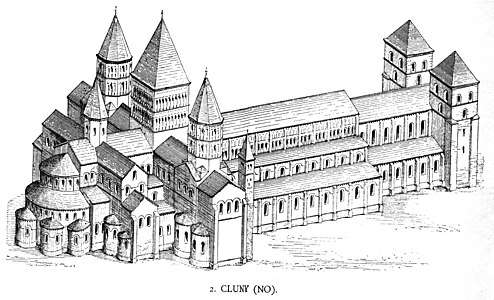1119 papal election
The 1119 papal election (held January 29 to February 2) was, by an order of magnitude, the 12th century's smallest papal election that is currently considered legitimate by the Roman Catholic Church.
| Papal election January–February 1119 | |
|---|---|
| Dates and location | |
| 29 January – 2 February 1119 Cluny Abbey, Cluny, Saône-et-Loire, France | |
| Elected pope | |
| Guy de Bourgogne Name taken: Callixtus II | |
 | |

Pope Gelasius II had died in Cluny having been expelled from Rome by Henry V, Holy Roman Emperor, as a result of the Investiture Controversy. Probably only two cardinal bishops, four cardinal priests and four cardinal deacons participated in the election. The election took place in Cluny Abbey in France, while the rest of the College of Cardinals remained in Rome. A non-cardinal Guy de Bourgogne, the Archbishop of Vienne, was elected Pope Callixtus II, and crowned in Vienne on February 9; Callixtus II reached Rome on June 3, 1120.[1]
Cardinal electors
Probably ten cardinals took part in the election.[2]
| Elector | Nationality | Cardinalatial order and title | Elevated | Elevator | Other ecclesiastical titles | Notes |
|---|---|---|---|---|---|---|
| Lamberto Scannabecchi, Can.Reg. | Fagnano | Cardinal-bishop of Ostia and Velletri | 1099 | Paschal II | Future Pope Honorius II (1124–1130) Dean | |
| Kuno von Urach | Germany | Cardinal-bishop of Palestrina | c. 1107 | Paschal II | ||
| John of Crema | Crema | Cardinal-priest of S. Crisogono | c. 1117 | Paschal II | Papal legate | |
| Guido Galli, O.S.B. | Italy | Cardinal-priest of S. Balbina | c. 1099 | Paschal II | ||
| Boso of Sant'Anastasia | Italy | Cardinal-priest of S. Anastasia | c. 1116 | Paschal II | ||
| Corrado de Suburra | Rome | Cardinal-priest of S. Pudenziana | Ca. 1111-1114 | Paschal II | Future Pope Anastasius IV (1153–1154) | |
| Gregorio Papareschi, Can.Reg.Lat. | Rome | Cardinal-deacon of S. Angelo in Pescheria | c. 1088 (or 1116) | Urban II (or Paschal II) | Archdeacon of the Holy Roman Church | Future Pope Innocent II (1130–1143) |
| Pietro Pierleoni | Rome | Cardinal-deacon of Ss. Cosma e Damiano | Ca. 1106-1116 | Paschal II | Future Antipope Anacletus II (1130–1138) | |
| Crisogono Malcondini | Pisa | Cardinal-deacon of S. Nicola in Carcere | 1117 | Paschal II | Chancellor of the Holy Roman Church | |
| Roscemanno Sanseverino, O.S.B.Cas. | Marsica | Cardinal-deacon of S. Giorgio in Velabro | c. 1106 | Paschal II | Of the Counts of Marsi |
Proceeding
The cardinals attending the death Mass of Gelasius II in Cluny in late January 1119 were divided over whether his successor should be elected on the spot (as was permitted by In Nomine Domini) or whether they should return to Rome and hold the election with the full College of Cardinals; although the cardinals proceeded with the election immediately, they agreed that they would submit their choice to the entire College thereafter.[3] The cardinals who accompanied Gleasius II to Cluny are known from the Liber Pontificalis associated with "Pandulphus" (either Pandulf of Pisa or Pandulf of Lucca), from the charter from Cluny, and from the chronicle of Ordericus Vitalis.[3]
Although the contemporary accounts diverge on many points, it is clear across them that the two candidates who emerged were Guy and Pontius of Cluny, both named as candidates by the late pontiff.[4] The account of Gaufrid, prior of Vigois, relates that Gelasius II had preferred Pontius and predicted his election; Pontius was a far more conciliatory candidate, likely to negotiate a solution to the Investiture Controversy.[4] Two accounts in particular—those of Bernard of Carrion and Gaufrid of Vigois—detail the election of Guy, emphasizing the importance of his known confrontational stance towards Henry V (having previously excommunicated him) and his powerful family, the Salian dynasty.[4]
Aftermath
At the time of his election as Callixtus II, Guy was in the company of his militia, which began rioting when it learned of his election, breaking into the election chamber and violently disrobing him, according to the Historia Compostelana.[5] Callixtus II proceeded to Sutri, the location of his opponent, Antipope Gregory VIII, appointed by Henry V, and laid siege to the city for eight days until Gregory VIII was handed over to him; Callixtus then imprisoned Gregory VIII in the Septizodium, from which the papal claimant was moved from monastery to monastery before his death in 1137.[6]
See also
Notes
- Miranda, Salvador. "Election of January 29 - February 2, 1119 (Callistus II)". The Cardinals of the Holy Roman Church. Florida International University.
- S. Miranda Election of 1119; Stroll, 2004, p. 58-59 and 61-62.
- Stroll, 2004, p. 58.
- Stroll, 2004, p. 59.
- Stroll, 2004, p. 64.
- S. Miranda Election of antipope Gregory VIII
References
- Stroll, Mary. 2004. Calixtus II (1119-1124): A Pope Born to Rule. BRILL. ISBN 90-04-13987-7.